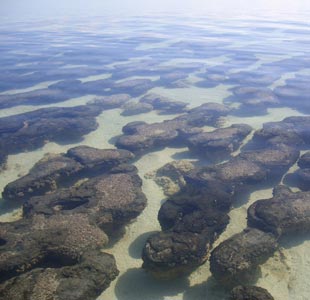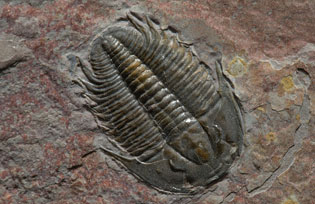Animal Evolution
Earlier emergence

The Precambrian period (see Geological Time) includes Earth's history from birth up to 590 million years ago and spans 88% of Earth's existence. All living things at this time began in the sea.
When the Earth was young and life was just beginning to evolve most organisms were single-celled, just as most organisms are today and consisted of bacteria and algae. These organisms lived together in colonies that were formed by trapping sediments and secreting mucus to bind particles together. As the colony grew, so did the structure that they made. In order to capture as much sunlight as possible, the shape of the top of the structure tended to be curved so that there was maximum exposure to the sun. These curved structures with multi-layered interiors are known as stromatolites.
Stromatolites are the oldest known fossils, originating over 3 billion years ago. Today stromatolites are nearly extinct, living a precarious existence in only a few localities worldwide, the most famous location being Shark Bay in Western Australia.
Ancient Stromatolites helped create the oxygen that made multi-cellular life possible, which then unfortunately made it impossible for stromatolites to exist.
The first known multi-cellular life shows up in the fossil record around 570 million years ago. The multi-cellular life of the Precambrian didn't look much like anything we can find in our modern oceans. Most of the large Precambrian organisms were built on a body plan unlike anything alive today. They were flattened mats of pasted-together tubes, spreading outward from a central core or axis, and in cross-section, they looked like an inflatable air-mattress.
The Cambrian explosion

The discovery of fossils from the Cambrian period almost 545 million years ago, prompted scientists to think the idea that this period may have been a genetic or environmental catalyst of early animal evolution.
The Cambrian Period marked an important point in the history of life on Earth; it was the time when most of the major groups of animals first appeared in the fossil records. This event is sometimes called the "Cambrian Explosion", because of the relatively short time over which a diversity of forms appeared.
During the Cambrian, the land was probably just about lifeless. Even fishes didn't exist yet. But there were many marine invertebrates that would look familiar today, including sponges, bivalves, and soft-bodied animals like jellyfish and worms. But the best known Cambrian animals are probably a group of armored creatures that no longer exist - trilobites.
These early fossil record suggests that exceptional evolutionary activity took place over 10 million years at the time of the Cambrian period and generated the ancestors of nearly all the animal groups living on Earth today, as well as others that failed to see modern times like the dinosaurs.